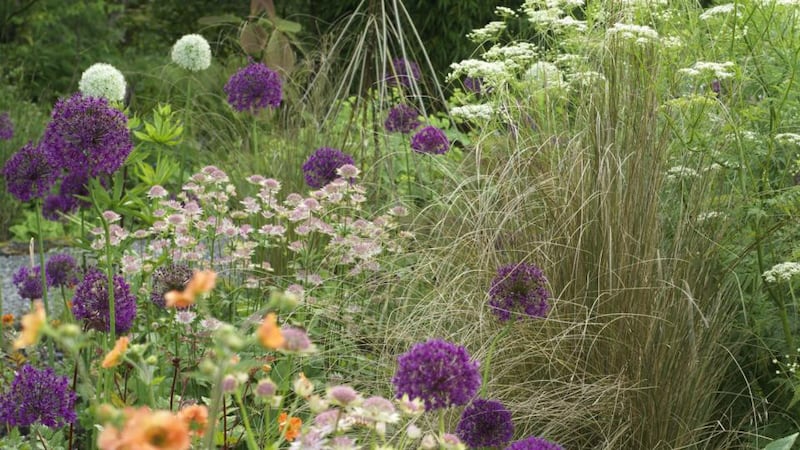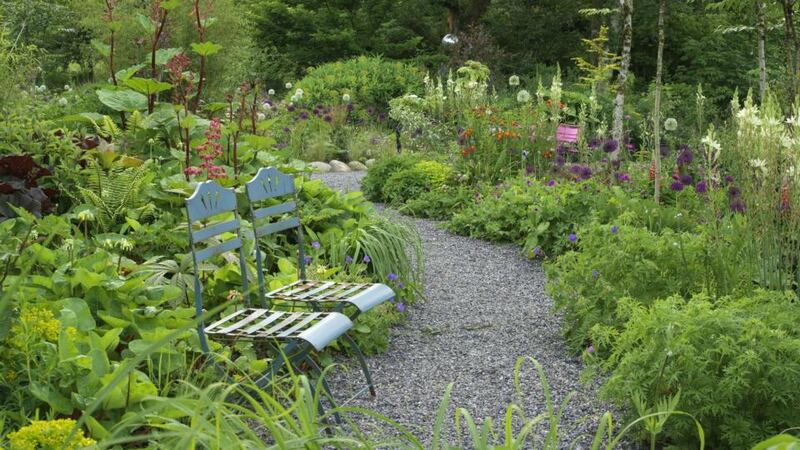I have a small confession to make about Hunting Brook, the 20-acre west Wicklow garden of the horticulturist, teacher and plant collector Jimi Blake (or "plant guru" as he was recently described in an article in the Telegraph), which is that I live nearby. And so I often walk the narrow, twisting, beech-lined country road that climbs steeply towards the top of the Lamb Hill, a route that takes you under the cathedral-like branches of elderly beech trees, past sloping meadows, across the tinkling river from which the garden takes its name and up to Hunting Brook's curlicued metal gates and its vast borders filled with plant combinations so fiercely colourful that they positively fizzle.
Stepping through the gates of Hunting Brook is like walking into an outdoor amphitheatre, but one where tiers of plants take the place of seats. Minimalism has never been its owner’s style; instead part of this idiosyncratic gardener’s brilliance lies in using dozens, sometimes hundreds, of a particular plant to dramatic effect.
A gifted propagator, most of these are grown by Blake from divisions of single plants bought by mail order, or on his numerous trips to specialist nurseries in Ireland and abroad. Among the tallest is the spiny Aralia echinocaulis, the deciduous tree/shrub Blake brought back from a plant-hunting expedition to the Hubei province of China more than a decade ago and which has since become one of his signature plants. A small, leafy army of them now stand sentry around his timber home, their distinctive silhouettes an integral part of the ambience of Hunting Brook.


Below the aralias grows a constantly changing palette of plants that reflects this very modern garden-maker’s unbounded enthusiasm for creative gardening, an enthusiasm he shares generously with those who visit the garden, or who have enrolled in one of the Plantsperson’s Courses that he runs at Hunting Brook twice a year. “The idea of just maintaining a garden rather than experimenting each year with different plant combinations bores me. I’m too curious, too excited by the introduction of new varieties and the opportunity to discover the most garden-worthy plants.”
The result is that Hunting Brook is forever in the process of metamorphosis. Those who visited it a decade or so ago, for example, will remember a very different garden, one that peaked in late summer/early autumn and was filled with fat clumps of golden Rudbeckia "Goldsturm", the silver-bronze Persicaria "Red Dragon" and giant stands of Miscanthus sacchariflorus. "All gone," says Blake with a grin. "I got bored of them." Also gone are many of the rarities he grew from seed sourced from obscure suppliers. "I went through a phase of seeking out strange or unusual plants until I discovered that many of them were a pain to grow. Now my aim is finding the very best, longest-flowering perennials and growing them in combination with the very best foliage plants in a way that's both modern and inventive. So while I still love late summer in Hunting Brook, now the garden looks great from early spring until the first hard frost."
In June this means that Hunting Brook's sunny borders are studded with mounds of starry astrantias, fat clumps of the magnificent purple-and-orange flowered "Masterpiece" lupin, orange alstroemerias, inky purple Salvia "Amistad", swathes of sky-blue Viola "Inverurie Beauty", ribbons of the magenta-flowering Geranium "Ann Thomson" and G "Mount Venus", and an ocean of purple and white alliums whose bobbles float above a haze of Geum "Prinses Juliana".
Oodles of wonderful foliage plants also grow in this garden, some herbaceous, some woody. On one steeply sloping bed far below the house's wooden deck, purple-leaved ligularias, rodgersias and ferns grow next to the giant leaves and crimson flower spikes of the Chinese rhubarb, Rheum officinale. Woody specimens include many different acers, stout specimens of the sweetly-scented Euphorbia stygiana and E. x pasteurii "John Phillips'', the neolithic-looking lancewood, Pseudopanax crassifolius and the handsome Kalopanax septemlobus. Perennials and woody plants are thoughtfully intermingled throughout, often with a generous smattering of hardworking summer-flowering annuals that this summer includes the shocking-pink Cosmos "Dazzler", burnt-orange Calendula "Neon" and the bi-coloured Tagetes "Tall Scotch Prize", all of which Blake has grown from seed.
Dahlias are another of his consuming passions. This year Blake has grown many from seed that he and his sister, June Blake, (the owner of another remarkable Irish garden, just a few fields away) sourced from British nursery owner Mark Fillan, in Devon. Other dahlias came as plants from the north Co Dublin dahlia expert Christopher White, or from the UK's National Dahlia Society. One is Dahlia "Poppy Scotland", whose vermillion, single red flowers Blake first spotted last year at the annual plant fair held in the gardens of Great Dixter in the UK. "Just one plant for sale, and someone else beat me to it. I was tempted to ask them if they really, really wanted it . . . Eventually I tracked it down through the National Dahlia Society."
Behind the house, Hunting Brook’s garden falls away towards a steep river gorge and the planting changes in mood and hue to take on a woodland theme, one distinguished by touches of whimsy as evidenced by a silver disco ball and a chandelier which dangle nonchalantly from overhanging tree branches.
Many of the specimen trees and shrubs that Blake has planted in this sloping woodland are still in their infancy. But in the meantime there are plenty of beautiful perennials to feast your eyes upon, including the fluffy-flowered Valerian pyrenaica. Follow the zig-zag of paths down to the gurgling river's edge and past the rough-hewn wooden banquet table, and a bridge leads you to another path and up to a wildflower meadow that brings you to a Bronze Age standing stone. "The meadow is one of my newer projects but I'm looking forward to seeing it evolve."
Long before he became a member of the Dublin Garden Group [he was invited to join six years ago], Blake was already a regular visitor to the gardens of its founding members, including those of Carmel Duignan and Helen Dillon as well as the late Anna Nolan. “Each of them influenced me as a gardener and taught me so much about good gardening techniques,” he says. “I still remember the thrill of being invited to join a group that includes some of the very best gardeners and gardens in Ireland.” As part of the Dublin Garden Group’s midsummer festival, Jimi Blake will be giving a talk to visitors to Hunting Brook tomorrow at 2pm, on his favourite plants for the June garden
The Dublin Garden Group Midsummer Festival Founded more than 20 years ago by some of the capital's most knowledgeable gardeners, membership of the Dublin Garden Group is by invitation only. This weekend the group is celebrating its first mid-summer festival with an open invitation to all to visit these exceptional gardens without prior appointment as usually required. For details, see dublingardens.com. Gardens open from 2-5pm, with an admission charge of €5. (Please note that some are already fully booked.) DIARY DATES Saturday, June 28th (2pm): National Botanic Gardens, Glasnevin. Speaking With Plants, with Dr Niamh Shaw (performer/scientist), her father Thomas P Shaw, Professor Bruce Osbourne of UCD, Dr Matthew Jebb, Director of the National Botanic Gardens, and Fionnuala Fallon. In association with EuroScience to mark Plant Biology Europe Congress taking place in DCC on June 23rd-29th. (Free, ticketed event, see www.ucdscienceexpression.ie/events/speaking-with-plants)













